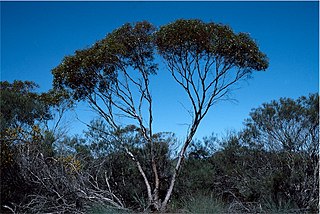
Eucalyptus horistes is a species of mallee or small tree that is endemic to Western Australia. It has smooth greyish bark, often with rough, firm fibrous bark on the base or all of the trunk, lance-shaped to elliptic adult leaves, flower buds in groups of between seven and thirteen, creamy white flowers and short cylindrical to shortened spherical fruit.

Eucalyptus laevopinea, commonly known as the silver top stringybark, is a tree that is endemic to eastern Australia. It has rough, stringy greyish bark on the trunk and larger branches, glossy green, lance-shaped adult leaves, flower buds in groups of between seven and eleven, white flowers and hemispherical or shortened spherical fruit.

Eucalyptus porosa, commonly known as mallee box, Quorn mallee or water mallee, is a species of mallee or a tree that is endemic to southern Australia. It has rough, fibrous or flaky bark on the trunk and larger branches, smooth greyish bark above, lance-shaped adult leaves, flower buds in groups of seven, white flowers and barrel-shaped or shortened spherical fruit.

Corymbia zygophylla, commonly known as the Broome bloodwood, is a species of small tree or a mallee that is endemic to Western Australia. It has rough, tessellated to fibrous bark on the trunk and branches, a crown of juvenile heart-shaped to lance-shaped, stem-clasping leaves, flower buds in groups of three or seven, white flowers and urn-shaped to shortened spherical fruit.

Eucalyptus staeri, commonly known as Albany blackbutt, is a species of small tree or a mallee and is endemic to the south-west corner of Western Australia. It has rough bark on the trunk and branches, thick, lance-shaped adult leaves, flowers buds in groups of between seven and fifteen, creamy white flowers and shortened spherical fruit.

Eucalyptus balladoniensis, commonly known as the Balladonia mallee, is a mallee that is endemic to an area in the south of Western Australia. It has rough bark on the lower half of its stems, smooth brownish bark above, lance-shaped leaves, flower buds in groups of seven, pale yellow flowers and hemispherical to more or less spherical fruit.

Eucalyptus fruticosa is a species of mallee that is endemic to Western Australia. It has rough, fibrous or flaky bark on the trunk, sometimes also on the larger branches, smooth pale brownish bark above, linear to narrow elliptical adult leaves, flower buds in groups of between seven and eleven, white to cream-coloured flowers and barrel-shaped to shortened spherical fruit.

Eucalyptus johnsoniana, commonly known as Johnson's mallee, is a species of mallee that is endemic to Western Australia. It has smooth, greyish brown bark, sometimes with flaky to fibrous brownish bark at the base, lance-shaped adult leaves, flower buds in groups of seven, creamy white flowers and shortened spherical fruit with an unusually small opening.

Eucalyptus jucunda, commonly known as Yuna mallee, is a species of mallee or small tree that is endemic to Western Australia. It has smooth bark, lance-shaped to curved adult leaves, flowering buds in groups of seven or nine, white or cream-coloured flowers and barrel-shaped or shortened spherical fruit with an unusually narrow opening.
Eucalyptus limitaris is a species of tree or mallee that is endemic to north-west Australia. It has rough, flaky or fibrous bark on the trunk and branches, lance-shaped to curved adult leaves, flower buds in groups of seven on a branching peduncle and conical to barrel-shaped or cup-shaped fruit.
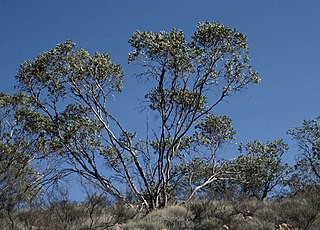
Eucalyptus oxymitra, commonly known as the sharp-capped mallee, is a species of mallee that is endemic to remote parts of Central Australia. It has rough bark on the trunk, smooth greyish bark above, lance-shaped to egg-shaped adult leaves, flower buds in groups of seven, white to pale yellow flowers and hemispherical fruit.
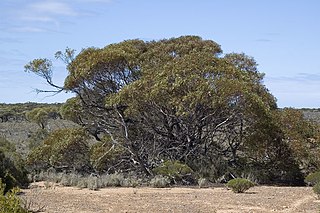
Eucalyptus yalatensis, commonly known as the Yalata mallee, is a species of mallee or a shrub that is endemic to southern Australia. It has rough, fibrous or flaky bark on the stems, smooth bark above, lance-shaped adult leaves, flower buds mostly in groups of nine, creamy white or yellowish flowers and hemispherical to shortened spherical fruit.
Eucalyptus remota, commonly known as the Kangaroo Island ash, Kangaroo Island mallee ash, or Mount Taylor mallee, is a species of tree or mallee that is endemic to Kangaroo Island in South Australia. It has smooth bark, often with rough, fibrous bark on the trunk, lance-shaped adult leaves, flower buds in group of between nine and twenty one, white flowers and hemispherical or shortened spherical fruit.
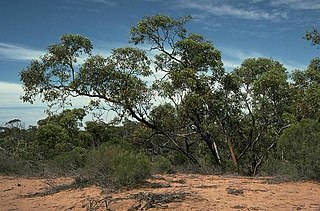
Eucalyptus yumbarrana, commonly known as the Yumbarra mallee is a species of mallee that is endemic to South Australia. It has rough, flaky bark on the lower trunk, smooth bark above, egg-shaped to lance-shaped adult leaves, flower buds in groups of seven, creamy white to yellow flowers and shortened spherical to cup-shaped fruit.

Eucalyptus corrugata, also known as rough fruited mallee or rib-fruited mallee, is a species of tree or mallee that is endemic to Western Australia. It has rough scaly or fibrous bark on the lower part of its trunk, smooth bark above, glossy, lance-shaped adult leaves, prominently corrugated flower buds arranged in groups of three in leaf axils and ribbed, conical to cup-shaped fruit.

Eucalyptus cylindrocarpa, commonly known as the woodline mallee, is a species of mallee that is endemic to Western Australia. It has mostly smooth bark, sometimes with loose fibrous or flaky bark near the base of the trunk, linear to lance-shaped or curved adult leaves, flower buds in groups of seven, nine or eleven and cylindrical to barrel-shaped fruit.
Eucalyptus delicata is a species of tree that is endemic to Western Australia. It has rough, fibrous to scaly bark on the trunk, smooth white to greyish bark above, linear to narrow lance-shaped adult leaves, flower buds in groups of between seven and eleven, creamy white flowers and more or less spherical to barrel-shaped fruit.
Eucalyptus hypolaena is a species of tree or mallee that is endemic to Western Australia. It has hard, dark grey bark near the base of the trunk, smooth bark above, lance-shaped adult leaves, flower buds arranged in groups of seven, pale yellow flowers and shortened spherical to barrel-shaped fruit.
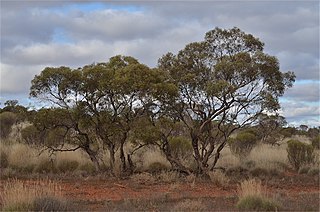
Eucalyptus socialis subsp. socialis, commonly known as the summer red mallee, is a subspecies of mallee that is endemic to inland south-eastern Australia. It usually has rough bark on the base of the trunk, smooth bark above, lance-shaped adult leaves, flower buds in groups of between seven and eleven, pale creamy white flowers and barrel-shaped to urn-shaped or spherical fruit.
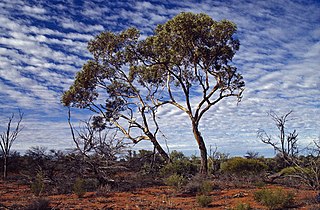
Eucalyptus socialis subsp. victoriensis, commonly known as the red mallee, is a subspecies of mallee that is endemic to southern inland Australia. It usually has rough bark on the base of the trunk, smooth bark above, lance-shaped adult leaves, flower buds in groups of between seven and eleven, pale creamy yellow flowers and barrel-shaped to urn-shaped or spherical fruit.















